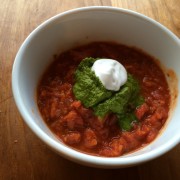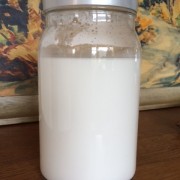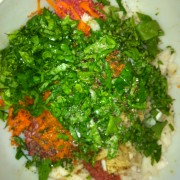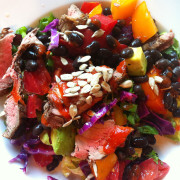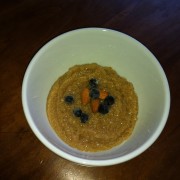I love this meal for many reasons. The rich and savory flavors from the robust marinara, the pesto and the mushrooms that infuse into the sweet and creamy cashew cheese are delicious. I usually make extra and freeze a couple for quick meals in the future. The cashew cheese is rich in good fats and minerals. The mushrooms will pack an extra immune punch with their antiviral properties, not to mention they are also rich in chromium, a nutrient that helps to balance blood sugars. Pesto is an excellent way to eat your greens. Leafy greens are a great source of calcium, magnesium and potassium for healthy muscles, bones and blood pressure to name a few. The zucchini replaces the pasta, so relax and enjoy this low glycemic, heart healthy dish! I did not have a picture of my vegan lasagna so you get a sweet and savory picture of my Etta instead.
Serves: 6
4 cups marinara sauce (see recipe below)
2 cups pesto (see recipe below)
3 cups cashew cheese (see recipe below)
4 medium zucchini, peeled into thin strips
¾ lb mixed mushrooms, crimini and shiitake mushrooms, sautéed (see recipe below)
- Preheat oven to 375 ⁰ F. In a 9 x 13 baking dish, begin layering lasagna beginning and ending with the marinara sauce. Use a quarter of each ingredient per layer. After the marinara sauce, next layer with the cashew cheese, pesto, zucchini, and then the mushrooms. Repeat process four times ending with the marinara sauce.
- Place the lasagna in the preheated oven and bake for 45 minutes or until bubbling and hot around the edges.
Robust Marinara Sauce
Yields: Approximately 8 cups
1 tablespoon extra virgin olive oil
1 large yellow onion, diced
6 large cloves garlic, diced
1- 28 oz. can diced tomatoes
1- 28 oz. can tomato sauce
½ cup oil packed sundried tomatoes, diced
1 ½ teaspoons dried thyme
1 ½ teaspoons dried oregano
1 teaspoon sea salt or to taste
1 teaspoon fresh cracked pepper
- In a large sauce pan over medium heat, sauté the olive oil, onions, garlic, thyme and oregano for approximately 3-5 minutes or until the onions are translucent.
- Add the remaining ingredients and stir until evenly blended. Reduce the heat to medium low and let simmer for 30-40 minutes, stirring occasionally. Remove from heat and set aside.
Pesto
Yields: Approximately 2 cups
2 cups fresh packed basil
2 cups packed arugula, kale (stems removed) or Italian parsley (stems removed)
2/3 cup walnuts
2/3 cup extra virgin olive oil
4 tablespoons fresh lemon juice
2 large cloves garlic
sea salt and fresh ground pepper to taste
- In a food processor or high powered blender, pulse the walnuts, garlic and greens until coarsely chopped.
- Add the lemon juice then slowly add the olive oil in a thin stream while the food processor or blender is on. Scrape the sides of the processor occasionally until the pesto is evenly blended.
- Sprinkle the salt and fresh ground pepper in the pesto to taste.
Cashew Cheese
Yields: Approximately 1 ½ cups
1 cup raw cashews
¾ cup water
¼ cup nutritional yeast
½ teaspoon sea salt
3 cloves garlic
- In a food processor or high powered blender, combine all ingredients and blend until the consistency of ricotta or until somewhat smooth.
Sautéed Mushrooms
Yields: Approximately 4 cups
2 tablespoons extra virgin olive oil
¾ pound mixed mushrooms, crimini and shiitake (washed, trimmed and cut into ¼ inch slices)
4 cloves garlic, diced
sea salt and fresh ground pepper to taste.
- Over medium heat, sauté the garlic and olive oil for 1-2 minutes. Add the remaining ingredients and sauté for approximately 8-10 minutes or until mushrooms are tender. Remove from heat and set aside.



